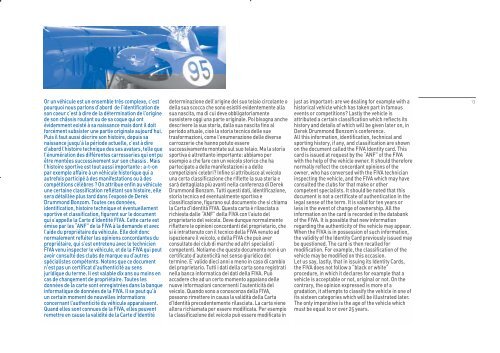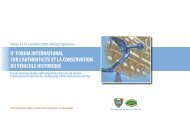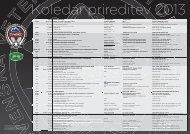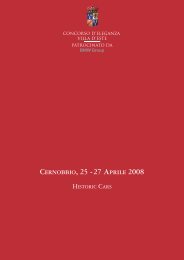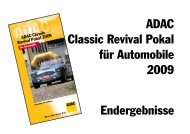FORUM INTERNATIONAL SUR L'AUTHENTICITE DU VEHICULE HISTORIQUE ...
FORUM INTERNATIONAL SUR L'AUTHENTICITE DU VEHICULE HISTORIQUE ...
FORUM INTERNATIONAL SUR L'AUTHENTICITE DU VEHICULE HISTORIQUE ...
You also want an ePaper? Increase the reach of your titles
YUMPU automatically turns print PDFs into web optimized ePapers that Google loves.
Or un véhicule est un ensemble très complexe, c’est<br />
pourquoi nous parlons d’abord de l’identification de<br />
son coeur c’est à dire de la détermination de l’origine<br />
de son châssis roulant ou de sa coque qui ont<br />
évidemment existé à sa naissance mais dont il doit<br />
forcément subsister une partie originale aujourd’hui.<br />
Puis il faut aussi décrire son histoire, depuis sa<br />
naissance jusqu’à la période actuelle, c’est à dire<br />
d’abord l’histoire technique des ses avatars, telle que<br />
l’énumération des différentes carrosseries qui ont pu<br />
être montées successivement sur son chassis . Mais<br />
l’histoire sportive est tout aussi importante : a-t-on<br />
par exemple affaire à un véhicule historique qui a<br />
autrefois participé à des manifestations ou à des<br />
compétitions célèbres ? On attribue enfin au véhicule<br />
une certaine classification reflétant son histoire, elle<br />
sera détaillée plus tard dans l’exposé de Derek<br />
Drummond Bonzom. Toutes ces données,<br />
identification, histoire technique et éventuellement<br />
sportive et classification, figurent sur le document<br />
qui s’appelle la Carte d’identité FIVA. Cette carte est<br />
émise par les “ANF” de la FIVA à la demande et avec<br />
l’aide du propriétaire du véhicule. Elle doit donc<br />
normalement refléter les opinions concordantes du<br />
propriétaire, qui s’est entretenu avec le technicien<br />
FIVA venu inspecter le véhicule, et de la FIVA qui peut<br />
avoir consulté des clubs de marque ou d’autres<br />
spécialistes compétents. Notons que ce document<br />
n’est pas un certificat d’authenticité au sens<br />
juridique du terme. Il est valable dix ans ou moins en<br />
cas de changement de propriétaire. Toutes les<br />
données de la carte sont enregistrées dans la banque<br />
informatique de données de la FIVA. Il se peut qu’à<br />
un certain moment de nouvelles informations<br />
concernant l’authenticité du véhicule apparaissent.<br />
Quand elles sont connues de la FIVA, elles peuvent<br />
remettre en cause la validité de la Carte d’Identité<br />
determinazione dell’origine del suo telaio circolante o<br />
della sua scocca che sono esistiti evidentemente alla<br />
sua nascita, ma di cui deve obbligatoriamente<br />
sussistere oggi una parte originale. Poi bisogna anche<br />
descrivere la sua storia, dalla sua nascita fino al<br />
periodo attuale, cioè la storia tecnica delle sue<br />
trasformazioni, come l’enumerazione delle diverse<br />
carrozzerie che hanno potuto essere<br />
successivamente montate sul suo telaio. Ma la storia<br />
sportiva è altrettanto importante: abbiamo per<br />
esempio a che fare con un veicolo storico che ha<br />
partecipato a delle manifestazioni o a delle<br />
competizioni celebri? Infine si attribuisce al veicolo<br />
una certa classificazione che riflette la sua storia e<br />
sarà dettagliata più avanti nella conferenza di Derek<br />
Drummond Bonzom. Tutti questi dati, identificazione,<br />
storia tecnica ed eventualmente sportiva e<br />
classificazione, figurano sul documento che si chiama<br />
la Carta d’identità FIVA. Questa carta è rilasciata a<br />
richiesta dalle “ANF” della FIVA con l’aiuto del<br />
proprietario del veicolo. Deve dunque normalmente<br />
riflettere le opinioni concordanti del proprietario, che<br />
si è intrattenuto con il tecnico della FIVA venuto ad<br />
ispezionare il veicolo, e della FIVA che può aver<br />
consultato dei club di marche od altri specialisti<br />
competenti. Notiamo che questo documento non è un<br />
certificato d’autenticità nel senso giuridico del<br />
termine. E’ valido dieci anni o meno in caso di cambio<br />
del proprietario. Tutti i dati della carta sono registrati<br />
nella banca informatica dei dati della FIVA. Può<br />
accadere che ad un certo momento appaiano delle<br />
nuove informazioni concernenti l’autenticità del<br />
veicolo. Quando sono a conoscenza della FIVA,<br />
possono rimettere in causa la validità della Carta<br />
d’Identità precedentemente rilasciata. La carta viene<br />
allora richiamata per essere modificata. Per esempio<br />
la classificazione del veicolo può essere modificata in<br />
just as important: are we dealing for example with a<br />
historical vehicle which has taken part in famous<br />
events or competitions? Lastly the vehicle is<br />
attributed a certain classification which reflects its<br />
history and details of which will be given later on, in<br />
Derek Drummond Bonzom’s conference.<br />
All this information, identification, technical and<br />
sporting history, if any, and classification are shown<br />
on the document called the FIVA Identity card. This<br />
card is issued at request by the “ANF” of the FIVA<br />
with the help of the vehicle owner. It should therefore<br />
normally reflect the concordant opinions of the<br />
owner, who has conversed with the FIVA technician<br />
inspecting the vehicle, and the FIVA which may have<br />
consulted the clubs for that make or other<br />
competent specialists. It should be noted that this<br />
document is not a certificate of authentication in the<br />
legal sense of the term. It is valid for ten years or<br />
less in the event of change of ownership. All the<br />
information on the card is recorded in the databank<br />
of the FIVA. It is possible that new information<br />
regarding the authenticity of the vehicle may appear.<br />
When the FIVA is in possession of such information,<br />
the validity of the Identity Card previously issued may<br />
be questioned. The card is then recalled for<br />
modification. For example, the classification of the<br />
vehicle may be modified on this occasion.<br />
Let us say, lastly, that in issuing its Identity Cards,<br />
the FIVA does not follow a “black or white”<br />
procedure, in which it declares for example that a<br />
vehicle is acceptable or not, original or not. On the<br />
contrary, the opinion expressed is more of a<br />
gradation, it attempts to classify the vehicle in one of<br />
its sixteen categories which will be illustrated later.<br />
The only imperative is the age of the vehicle which<br />
must be equal to or over 25 years.<br />
13


